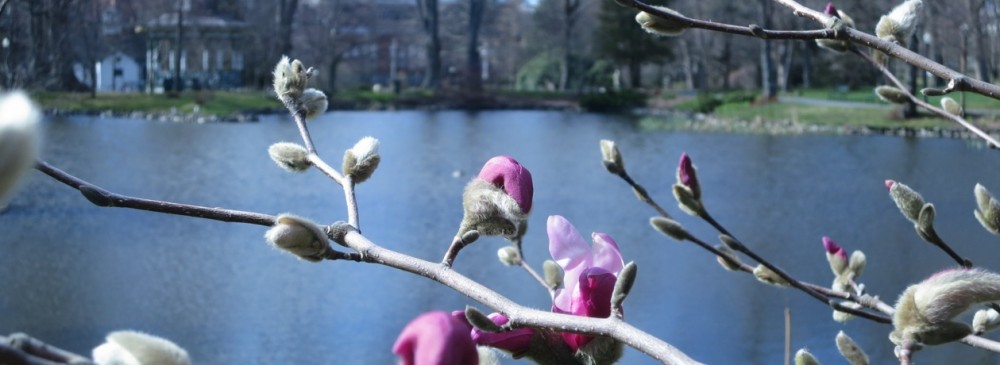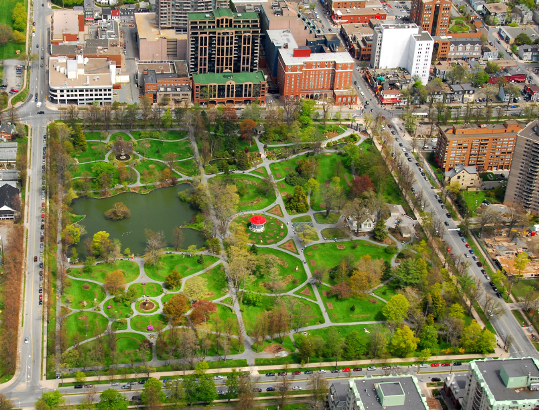Today marks the 10th anniversary of Hurricane Juan.
We all remember that night.
The sound of the wind barreling down on us, the shredded leaves plastered to all vertical surfaces, the smell of trees, and in the morning light… the terrible destruction.
It struck at 12:10 AM on September 29, 2003 with a ferocity few expected, and by day break the Public Gardens had been transformed.
On the surreal morning after, people gathered outside the perimeter fence of the Gardens in shocked disbelief at the destruction within.
80 mature trees toppled, taking down (or up as was often the case) wiring, sod, and any solid structure in its path.
The military had to be sent in first to hack its way through the branches, clearing a path for the machines that would follow.
 The alleé along Summer St. lost many of the Linden trees by the perimeter fence. These trees were planted around the mid 1870’s to early 1880’s.
The alleé along Summer St. lost many of the Linden trees by the perimeter fence. These trees were planted around the mid 1870’s to early 1880’s.
The area around the main gates and the bridges were one of the areas most affected. Walkways were ripped up, the edges of the streams and lower pond crumbled, and the foundation of the main gates were undermined when the massive trees were felled.
Post Juan. The biggest loss of trees occurred along the Grande Alleé (to the left of the bandstand). In the pre-Juan photo you can’t even see the walkway. The southeast corner of the Gardens (top right hand) was also heavily damaged. Many trees were also lost around Griffins pond.
The Gardens remained closed for 9 months + 1 day and in that time an amazing transformation occurred.
You don’t know what you got till it’s gone! No truer words were sung.
When Haligonians saw the destruction of the Gardens, they realized how valuable a space this was. This inspired an unprecedented outpouring of generosity.
Thanks to a weekend radiothon put on by the Maritime Broadcasting Systems the public (many from far away) showed their love and donated over $1,000,000 toward the reparation and restoration of the Gardens.
The Public Gardens Foundation was founded. It consisted of a diverse group of people with the common goal of restoring the Gardens and more importantly, they had money to do it. Partnering with HRM, they undertook to identify what needed to be done, who should do it and what it should look like.
The first task was to remove the felled giants. This uncovered the scope of the damage. Regular maintenance of the Gardens had been deferred for a long time and now was the opportunity to fix the things that had been neglected , and to change and upgrade those elements that were past their due date.
The leafy main entrance of the Gardens pre-Juan, featured a statue of Sir Walter Scott in front of a wall which served to block the view of the beautiful gates.
Today, the main gates can be viewed in its entirety after the statue was moved. New raised beds were built to display annual flowers and provide seating, and a new interlocking paving plaza replaced the cracked sidewalk. The gates were taken down, stripped, and re-painted. The central gates were also restored so that they can be opened.
The biggest transformation occurred in the Southeast quadrant of the Gardens.
Griffins pond was in need of a recirculating water system to help conserve and oxygenate the water, which had become stagnant when the brook which fed it, was inadvertently deviated during the blasting of the Infirmary hospital.
 Starting at the pond in the Bird Enclosure, the stream bed was widened and terraced and the edges finished. The loss of large trees brought in lots of sunlight and created the opportunity to plant a beautiful border along the stream bed and lower pond.
Starting at the pond in the Bird Enclosure, the stream bed was widened and terraced and the edges finished. The loss of large trees brought in lots of sunlight and created the opportunity to plant a beautiful border along the stream bed and lower pond.
 Today this spot is the most photographed place in the Gardens. Where did the grads and newlyweds have their photos taken before?
Today this spot is the most photographed place in the Gardens. Where did the grads and newlyweds have their photos taken before?
 The filtration system for the pond was housed in the old waterfowl house which was spruced up and has become a lovely, tranquil spot to sit and gaze over the water.
The filtration system for the pond was housed in the old waterfowl house which was spruced up and has become a lovely, tranquil spot to sit and gaze over the water.
 Another lovely sitting spot. Horticultural Hall (formally known as the Canteen) was beautifully restored, inside and out. It’s been transformed into a light filled space with a soaring ceiling and whitewashed walls. Now it’s a proper cafe and a wonderful place to grab a coffee or a bite to eat, and meet some friends.
Another lovely sitting spot. Horticultural Hall (formally known as the Canteen) was beautifully restored, inside and out. It’s been transformed into a light filled space with a soaring ceiling and whitewashed walls. Now it’s a proper cafe and a wonderful place to grab a coffee or a bite to eat, and meet some friends.
The cupola was replaced in 2006, 60 years after it had been taken down .
 The Grande Alleé probably lost the most trees of any area in the Gardens and it will take decades before it once again resembles the green tunnel Richard Power intended it to, when he planted the parallel lines of Ulmus americana (American Elms) in the mid 1870’s.
The Grande Alleé probably lost the most trees of any area in the Gardens and it will take decades before it once again resembles the green tunnel Richard Power intended it to, when he planted the parallel lines of Ulmus americana (American Elms) in the mid 1870’s.
 Princeton Elm trees (Ulmus americana ‘Princeton’) have been planted along the Grande Alleé in place of the lost trees. This variety is Dutch Elm disease resistant… just in case.
Princeton Elm trees (Ulmus americana ‘Princeton’) have been planted along the Grande Alleé in place of the lost trees. This variety is Dutch Elm disease resistant… just in case.
 The newest addition to the Public Gardens is called Horticultural Hall Plaza. A fountain sits at its center with washrooms on either side (though you’d never guess that the pretty trellised buildings were washrooms).
The newest addition to the Public Gardens is called Horticultural Hall Plaza. A fountain sits at its center with washrooms on either side (though you’d never guess that the pretty trellised buildings were washrooms).
 Looking from a decade on, I’d say the efforts of the PG Foundation on behalf of a generous and appreciative public, have been a tremendous success. Thank you all for your efforts.
Looking from a decade on, I’d say the efforts of the PG Foundation on behalf of a generous and appreciative public, have been a tremendous success. Thank you all for your efforts.
The Public Gardens are experiencing something of a Renaissance, which is fitting… the Victorian era brought about a renaissance in gardening which ultimately fed the vision for this Public Gardens.
The projected cost of the multi phased restoration of the Gardens was $3,000,000
Beyond the ‘sexy’ parts of the Gardens which were restored, a tremendous amount of ‘background’ work was done.
New wiring for all the lights were installed, the paths were properly drained and widened, new sod was put down, the ponds were edged, the beds were re-cut and top dressed. I particularly like the removal of the log railings around the ponds. Borders are just as effective but a much prettier way to keep people away from the water.
They say that if you don’t learn a lesson from a negative event that you lose twice.
Juan taught us to value what we had in our midst, but it also highlighted the poor shape of the Gardens due to maintenance deferrals.
It was a blessing that the people donated so generously and that the hurricane relief fund was available to fund the projects that were already in dire need.
We mustn’t lose sight of the fact that constant maintenance is a … well, constant in the life of a well populated Garden in the heart of an urban center. And it must be undertaken constantly or it all adds up pretty quickly.
It’s a never-ending labour of love, but well worth the effort!
Thank you to HRM for the old photographs. They come from a collection of CD’s, Power Point presentations and archival material.
All copy copyright © Serena Graham-Dwyer, 2013. If you wish to use any part or whole of an image, in any manner, please contact us.








